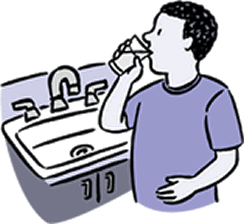
|
|
|
|
Some say that passing a kidney stone is like delivering a baby made of razor blades. The good news is that, although they can be excruciatingly painful, kidney stones rarely cause permanent damage, and you may be able to prevent them.
Back or side pain that won’t go away is the primary symptom of a kidney stone. You may also have pinkish or foul-smelling urine, fever or painful urination. Experts say that the incidence of kidney stones is on the rise, although no one knows why. Caucasians are more prone to kidney stones than African Americans, and men are more prone than women. Age is also a factor. The chance of getting a kidney stone rises as men enter their 40s and continues to rise into their 70s. For women, the risk peaks in their 50s.
Each day, about 50 gallons of blood flows through your kidneys. The kidneys remove waste products, including various minerals and other substances, from the blood and transfer them into urine so your body can get rid of them. In people who get stones, certain minerals in the urine combine with other waste products and start to form a stone.
Kidney stones aren’t all the same. The most common type is made of the mineral calcium, combined with either oxalate or phosphate. Less common types of stones are made of uric acid or other chemicals, all of which are naturally found in the body. No one knows why these substances form kidney stones in some people but not in others, since we all have them in our urine. Stone formation may be related to the levels of these substances in urine or to other currently unknown factors that encourage or inhibit stone formation.
Most kidney stones eventually pass out of the body during urination. But some can grow large enough to begin blocking the flow of urine. That causes intense pain and may also put you at risk for infection.
Most kidney stones that don’t pass on their own are treated in an outpatient setting. The most common procedure is called lithotripsy. Greek for “stone crushing,” this technique uses shock waves to reduce kidney stones into small fragments, which then easily flow away in urine.
If you’ve had more than one kidney stone, you’re at higher risk for forming another. But there are ways to help prevent most types of kidney stones. First, your doctor needs to know what type of stone it is. If you pass a stone, try to catch it in a strainer. A laboratory analysis can help your doctor plan a strategy to prevent more stones. Other tests, which may include urine and blood tests, can help your doctor figure out why you had a kidney stone. Your medical history, occupation and eating and drinking habits can also hold clues.
Drinking more water may help prevent kidney stones. Depending on the type of stone you’re at risk for, your doctor may also advise you to avoid certain foods or drinks. For example, people prone to forming calcium oxalate stones should avoid spinach, peanuts and chocolate. People prone to uric acid stones should cut back on meat. Doctors can also prescribe certain medications to help prevent these types of stones.
NIH continues to fund research on the causes, treatments and prevention of kidney stones. In the meantime, make sure to see a doctor if you think you have a kidney stone. While most pass out of the body on their own, some just won’t go away by themselves. |

